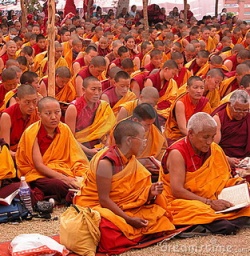Emptiness; Nothingness; Void
‘Emptiness (also called Nothingness or Void): in mysticism and religion, a state of ‘pure consciousness’ in which the mind has been emptied of all particular objects and images; also, the undifferentiated reality (a world without distinctions and multiplicity) or quality of reality that the emptied mind reflects or manifests.
The concept, with a subjective or objective reference (sometimes the two are identified), has figured prominently in mystical thought in many historical periods and parts of the world.
The emptying of the mind and the attainment of an undifferentiated unity is a theme that runs through mystical literature from the Upanishads (ancient Indian meditative treatises) to medieval and modern Western mystical works.
The concepts of Hsü in Taoism, Sunyata in Mahayana Buddhism are pertinent examples of ‘Emptiness’, or ‘Holy Nothing’, doctrines.
Buddhism, with its basic religious ultimate of Nirvana, as well as its development of the Sunyata doctrine, has probably articulated emptiness more fully than any other religious tradition; it has also affected some modern Western considerations of the concept.
A good deal of 19th-20th century Western imaginative literature has been concerned with emptiness, as has a certain type of Existentialist philosophy and some forms of the Death of God movement.
The particular meanings of ‘Emptiness’ vary with the particular context and the religious or cultural tradition in which it is used. (Encyclopaedia Britannica).
•••••••••••••••••••••••••••••••••••••••
Hsü: (Chinese: ‘emptiness,’ or ‘purity’): in Chinese Taoism, a state of being that is characterised by total tranquillity and transcendence of self, through which individual consciousness is believed to become one with the Tao; the Tao, or Way, constitutes absolute reality and cannot be defined or understood in human terms except through individual experience of Hsü. (Encyclopaedia Britannica).
Sunyata: in Buddhist philosophy, the voidness that constitutes ultimate reality; Sunyata is seen not as a negation of existence but rather as the undifferentiation out of which all apparent entities, distinctions, and dualities arise. Although the concept is encountered occasionally in early Pali texts, its full implications were developed by the 2nd-century Indian philosopher Nagarjuna.
The school of philosophy founded by him, the Madhyamika (Middle Way), is sometimes called the Sunyavada, or Doctrine That All Is Void. (Encyclopaedia Britannica).
En Sof: the Infinite; the unknowable God.
Nirvana: According to the Buddhist analysis of the human situation, delusions of egocentricity and their resultant desires bind man to a continuous round of rebirths and its consequent suffering (dukkha).
It is release from these bonds that constitutes Enlightenment, or the experience of Nirvana.
Liberation from rebirth does not imply immediate physical death; the death of an arhat (a perfected person) or a Buddha is usually called Parinirvana, or complete Nirvana’.

